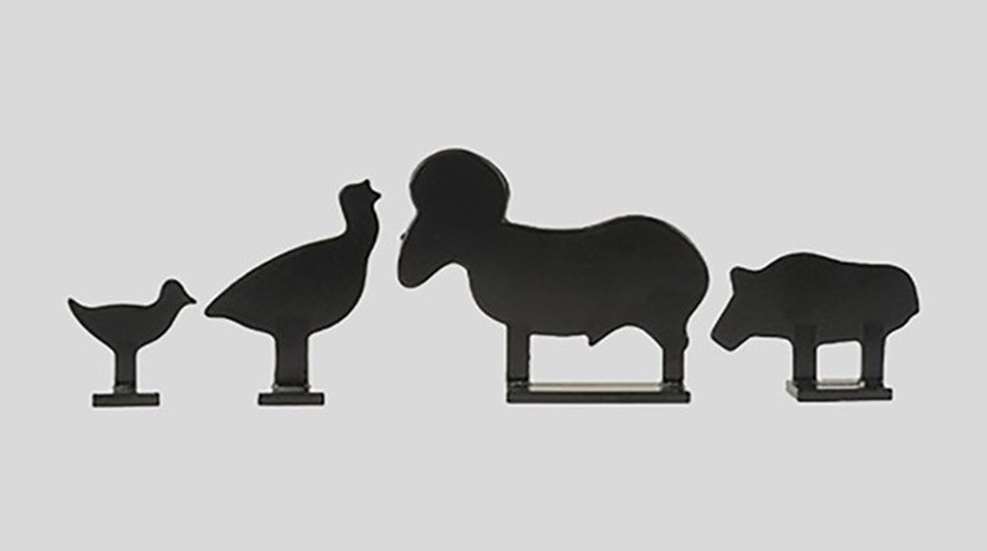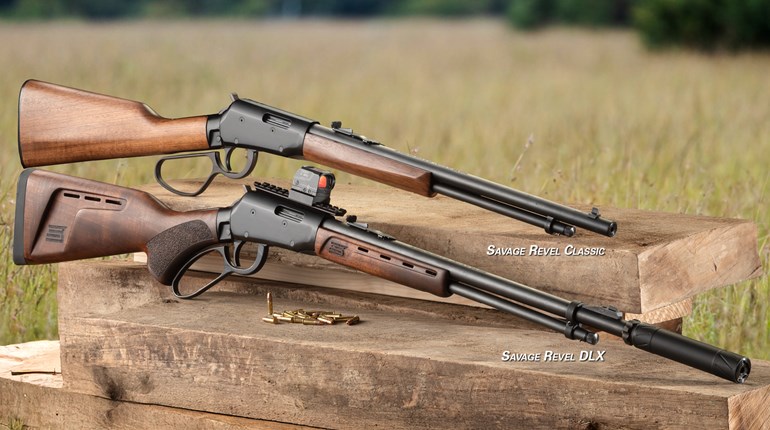
From the vault: Little bullets and tiny targets add up to a big competitive challenge in smallbore metallic silhouette rifle competition. Read this introduction to the discipline written by Scott Engen and published in the May 2001 issue of Shooting Sports USA.
Putting Lead To Steel: An Introduction to Smallbore Metallic Silhouette Rifle Shooting
By Scott Engen
You snap the rifle bolt into battery and chamber the last round of the match. The afternoon desert sun beats down on you with fervor. Its heat boils the air and your last target looks like it's lying at the bottom of a deep swimming pool. You double-check your head position on the stock and settle the crosshairs into the center of the target. Breathe, wait, start the trigger press, steady and crack! The little chunk of lead races downrange almost before you're ready. A split-second later, the rsounding ring of a bullet on steel returns to your ears. You watch your last ram make a graceful pirouette off the rail and disappear into a cloud of West Texas dust. That's it. The last ram. Forty shots and 40 hits. You've just gone clean for the first time in a Smallbore Metallic Silhouette Rifle Match. The crowd goes wild! You just can't stop smiling, can you?
Metallic silhouette rifle shooting originated in Mexico, where they call it Siluetas Metalicas. It originally used live farm and game animals staked out downrange as the targets, with the winner being the first shooter to draw blood on the target animal and thus win the critter for their own dinner table. Since the live-target format was rather hard on the local livestock, the matches soon evolved into using animal-shaped metal plates, and rules required knocking over the hefty target to score a hit. The new all-steel format quickly became popular with local rifle shooters. Since then, the silhouette game has also added both pistol and blackpowder cartridge rifle shooters to the fold as well.
The original center-fire rifle game uses target placed at distances out to 500 meters—more than a quarter mile away. Add to that the huge lateral safety zones and bullet impact area and we start talking about a major piece of real estate required to safely hold a high power silhouette rifle match. There are limited locations available in an increasingly organized world where suitable high power silhouette ranges can be built, so rather than give up the game, it was adapted and scaled down to a smallbore level.
There are still some shooters who look down their noses at the smallbore version of any center-fire shooting game. Many eventually realize that the smallbore variant holds at least as much challenge as the original high power format. Shooting those lightweight, blunt-nosed, slow-moving .22 LR bullets in a gusty crosswind becomes every bit as difficult as rolling rams at 500 meters with a scoped .308 Win. and heavyweight Sierra MatchKings. Better yet, you don't have to drive across parts of three states to do it, either. Competitors who take advantage of the smallbore version also tend to have their names found atop the results lists in the center-fire matches as well, specifically because they have had so much additional practice and match experience hammering on those rimfire rams. There's an important lesson to the wise shooter here.
The NRA conducts smallbore rifle silhouette competition in nearly every state of the union. You can find a match near you by looking in the “Coming Events” section of Shooting Sports USA, or by contacting your NRA state association.
Smallbore rifle silhouette is a microcosm of the high power silhouette game. The rimfire rifle targets are one quarter-to one half-inch thick plate steel, about one fifth the size and set at one fifth the firing distances of the center-fire rifle format. The shooting techniques, match conduct and protocols are nearly identical to the center-fire version. This means those who are familiar with the center-fire version will feel right at home, and those who have never shot the game can give it a try with their favorite small game rifle.
All shooting is done from the standing position, without the support of a sling or palm rest. Clothing is your usual field or hunting attire, suitable for the prevailing weather. The heavy padded rifle shooting coats, multiple sweatshirts, rifle pants and padded gloves so familiar to the National Matches rifle crowd are not allowed—that alone ought to be enough to make anyone who has had to suffer in utter, profound, sweat-soaked misery on a hot, humid Ohio afternoon want to take a look at this game. Many competitors prefer to use some variation on the traditional mesh-backed skeet or trap shooting vest. You can be comfortable and competitive at the same time. Always remember your eye and ear protection as well, as even the little .22 rimfire can take its toll on hearing and eye sight if not property respected.
The usual course of fire is 40 shots—one round at each of the 40 targets. Each of the four types of target animals is presented to the shooter in two banks of five targets each and must be engage in proper sequence and knocked over to score a hit. Targets engaged or hit out of order, or turned but not knocked over are scored a miss. The total number of targets hit count for score. Shoot-offs are used to break any ties. The competitor has 2½ minutes to fire their five shots on each bank of five targets. Each shooter may have a coach/spotter on the firing line to help them spot the impact point of their shots, give sight corrections and to help keep track of time and score.
Ten chicken targets are set at 40 meters; 10 pigs at 60 meters; 10 turkeys at 77 meters, and 10 rams are set at 100 meters. Because of the irregular shape of the targets, a steady hold on the center of the target and careful sight adjustments for each range are critical. Reading and compensating for wind and mirage are also critical skills for the smallbore silhouette competitor.
Rifles for smallbore silhouette are chambered for the unmodified factory .22 rimfire cartridge. Here, the .22 LR cartridge is king. You’ll usually see serious competitors using high-grade match ammunition carrying a 40-grain bullet, such as CCI Green Tag, Eley Tenex, Federal Ultra Match or RWS R50.
You may even encounter specialized metallic silhouette rimfire ammunition like Winchester’s Super Silhouette or RWS R100, often throwing a bullet of up to 45 grains for a little more juice downrange when the lead meets the steel. Those extra few grains of bullet weight can add a measure of confidence when the rams seem welded to the support rails. The rules prohibit hyper-velocity .22 LR rounds, like the CCI Stinger or magnum rimfire chamberings, such as .22 WMR, because they cause accelerated target wear and damage.
The smallbore rifles used in silhouette fall into two classes under NRA rules. The Smallbore Silhouette Rifle class allows for any safe rifle weighing not more than 10 pounds, two ounces, including sights. Barrels are a maximum of 30 inches in length. Stock designs are generally fairly traditional, with specific limits on width, depth and comb or cheekpiece dimensions. Trigger weight is at the discretion of the shooter, but must be safe. Rules prohibit programmed or release triggers. Any action type is allowed and five-shot magazine-fed bolt-action repeaters from Anschütz, Kimber, Remington, Ruger, Winchester and others have long been the guns of choice. (See the latest NRA silhouette rifle rules here.)
Conventional and international smallbore bullseye shooters can pick up a stock suitable for metallic silhouette shooting and just drop the barreled action from their Anschütz or other rimfire match rifle into it, mount up a big scope and give the game a try as well.
Recently, the smallbore silhouette game has seen major inroads made by the ultra-accurate, heavy barreled custom semi-automatic, often based on the Ruger 10/22 platform or its clones. Many shooters block- or pillar-bed the action and free-float the barrel on the little Ruger autoloader and mount the scope on a cantilevered base mounted on the rear of the barrel. Other gunmakers are now moving in this direction with the likes of the Marlin 7000 and the Remington 597 self-loading match guns.
There has also been some technology crossover between disciplines. Equipment originally developed for silhouette go into guns built for events like the Chevy Truck Sportsmen’s Team Challenge and vice versa. Repeaters, especially self-loaders, may have an advantage in that the shooter does not have to break position to load a new cartridge between each shot. I’d suspect that you might even be able to shoot your AR-15-type DCM service or NRA match rifle with a Colt or J.A. Ciener rim-fire conversion kit if you were so inclined.
Any sights may be used and mid-to-high magnification target scopes are most popular. The choice of magnification must be balanced between the stability of the shooter’s hold under existing conditions and the need to clearly see the target. Variable scopes with target-style knobs like the Leupold 6.5-20X AO, Tasco 6-24X or the Burris 6-18X are very popular. Shooters may dial down the scope’s power for closer targets or windy conditions and crank it up for ringing those rams at 100 meters. An adjustable objective bell for parallax correction is critical for predictable and repeatable accuracy at the four different distances fired. Choice of reticles is up to the shooter, but the ½ to ¼ minute target dot or fine duplex reticles seem to be the most popular.
The Smallbore Hunting Silhouette Rifle Class, sometimes called the Light Rifle class, is much like the gun just described, but is limited to a weight of 8½ pounds and may be a single-shot. The hunting/light rifle class gun must be a regular factory catalog item available to the public. Trigger pulls need be at least two pounds, and the original factory stock must be used. You can bed the action and/or barrel, paint or refinish the stock and add a new barrel of the same light weight as the original factory barrel. These rules make this class less of a technology race and help keep equipment costs down. This class is also intended to allow the first time or informal competitor to get started by using their squirrel or rabbit rifle, rather than buying a new rifle just to try the silhouette game. The initial purchase price of a new match rifle for many shooting disciplines sometimes carries the price tag of a good used car, and is often a major hurdle for many who would otherwise like to try competitive shooting.
Understanding the smallbore silhouette game is really simple—you knock the correct target over, you score a point. Anything else is a miss. The guns are easy to operate, light enough for almost anyone to heft, and the recoil and report is not intimidating. Ammo is affordable. Ranges are short and locally accessible. The novice quickly learns the basics of stance, hold, trigger control, sight picture and other rifle shooting techniques. They learn how to quickly zero sights and adjust them for different distances and conditions. They learn about winning and losing, and about playing the game fairly. Most of all, they learn that shooting is fun, safe and enjoyable.
Learn more about the NRA Silhouette discipline at competitions.nra.org.

































